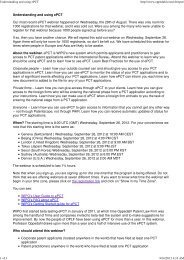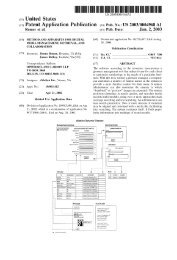Polaroid Corp. v. Eastman Kodak Co. - Oppedahl Patent Law Firm LLC
Polaroid Corp. v. Eastman Kodak Co. - Oppedahl Patent Law Firm LLC
Polaroid Corp. v. Eastman Kodak Co. - Oppedahl Patent Law Firm LLC
You also want an ePaper? Increase the reach of your titles
YUMPU automatically turns print PDFs into web optimized ePapers that Google loves.
Intellectual Property Library ISSN 1526-8535<br />
have been developed. Instead, <strong>Polaroid</strong> would have focused its efforts on the Sun camera<br />
series and brought them to market earlier.<br />
<strong>Polaroid</strong> sold the most film in its history in 1980. Camera sales, in contrast, continued to<br />
decline as did their profitability. <strong>Polaroid</strong> introduced "The Button" camera in August<br />
1980, but it was nothing more than the OneStep with a new finish, priced about $10 less.<br />
Between 1977 and 1980 the margin on the OneStep decreased fifty percent. The margin<br />
on film remained the same but during this time period, the price of SX-70 film, in<br />
constant dollars, actually declined from $4.64 to $4.06.<br />
Both <strong>Kodak</strong> and <strong>Polaroid</strong> recognized that the key to increasing profit in this period was to<br />
raise prices but were apprehensive about how price increases, especially on film, would<br />
affect demand. While mindful of the keen competition within the instant camera market,<br />
both companies were increasingly concerned with the growing threat of conventional<br />
35mm photography and advances in photofinishing quality and speed. <strong>Polaroid</strong> began<br />
studying the 35mm photofinishing business in 1979. By the early 1980's 35mm<br />
photography had dropped in price so as to compete directly with instant photography.<br />
Page 1488<br />
In 1981, Mr. McCune asserted that, "I think we could all agree that our major<br />
competition comes from conventional photography - not <strong>Kodak</strong> instant. It is 35mm sales<br />
that have grown at the expense of instant." (DF 61,742). In 1981, Mr. Booth reported to<br />
<strong>Polaroid</strong>'s Board of Directors that the relative price of instant and conventional prints was<br />
a major concern. He reported that anything more than a five percent increase in film<br />
price would widen the "already high" two-to-one ratio between the price of an instant and<br />
conventional print.<br />
The introduction of Time Zero film gave <strong>Polaroid</strong> the chance to raise film prices by six<br />
percent in March 1980, double the usual annual increase of three percent. This increase<br />
followed a <strong>Kodak</strong> increase in January 1980. In January 1981, <strong>Kodak</strong> again increased its<br />
film prices, this time by almost ten percent. <strong>Polaroid</strong> followed <strong>Kodak</strong>'s lead in February.<br />
During this time period, <strong>Kodak</strong> also began to concentrate its efforts on the premium<br />
channel of distribution, selling cameras to companies for use as promotional incentives or<br />
prizes. These cameras were sold at a considerable loss to <strong>Kodak</strong> and generated few film<br />
sales.<br />
<strong>Polaroid</strong> introduced its Sun series of cameras and film in June 1981. The cameras were<br />
<strong>Polaroid</strong>'s first models with built-in flash. In combination with the high-speed film, the<br />
Sun cameras allowed shorter exposure times, extended indoor flash ranges, and had a<br />
smaller aperture opening, which improved the photograph's depth of field. The Sun 660,<br />
with state-of-the-art automatic focusing, was dealer priced at $62.50. The 640 model,<br />
without automatic focusing, had a dealer price of $46.50. Unfortunately, in 1981 and<br />
1982, <strong>Polaroid</strong> sold only half the number of Sun cameras predicted. 1981 was the first<br />
year that <strong>Polaroid</strong> had an overall negative gross margin on camera sales.<br />
<strong>Kodak</strong> introduced a new series of its own in 1982. The Kodamatic series included<br />
<strong>Kodak</strong>'s lowest-priced camera to date, the Kodamatic Champ, which had a dealer price,<br />
after rebates, of $19.95. Three other cameras <strong>Kodak</strong> introduced at this time were priced<br />
in the mid-range. The top of the line was the auto-focusing Kodamatic 980L which, after<br />
rebates, sold to dealers at $74.45. The Kodamatic 960 low net price was $49.95 and the<br />
<strong>Co</strong>pyright 2003, The Bureau of National Affairs, Inc. Reproduction or redistribution, in<br />
whole or in part, and in any form, without express written permission, is prohibited except<br />
as permitted by the BNA <strong>Co</strong>pyright Policy. http://www.bna.com/corp/index.html#V<br />
12





